Study on Dynamic Behavior of Bridge Pier by Impact Load Test Considering Scour
Abstract
1. Introduction
2. Test Set-Up
2.1. Specifications of the Full-Scale Model Pier and the Cheongnyangcheon Bridge Pier
2.2. Non-Destructive Impact Vibration Test Method
3. Results
3.1. Mode Number Analysis for the Analysis of the Test Results
3.2. Experimental Analysis Method
3.3. Full-Scale Pier Test Results
3.4. Field Pier Test Results
4. Discussion
4.1. Analysis of the Influence of the Surcharge Load through the Full-Scale Pier Test
4.2. Analyzing the Influence of the Scour through the Field Pier Test
5. Conclusions
- Using the numerical analysis, the eigenvalue and mode number of the pier were derived according to the direction of impact. Based on this, the test method for the piers that can derive the first, second, and third modes was established through the full-scale model pier test and the field pier test.
- Through the full-scale model pier, the natural frequencies of the first, second, and third modes were derived when the surcharge load on the pier increased. It was determined that the natural frequency of the first mode decreased as the surcharge load increased, and the second and third modes were not significantly affected by the surcharge load.
- Through the field pier test, scour was simulated on the ground that was adjacent to the side of the pier to measure the natural frequency when the scour occurred. Due to the influence of the scour, the first mode exhibited the largest decrease in the natural frequency, followed by the second and third modes. In the case of the third mode, the amplitude of the acceleration was significantly small on the side that simulated the scour even though the natural frequency change was the smallest. This indicates that the direction of the scour can be determined through the third mode.
- The results of the full-scale model pier test and the field pier test showed that the mode number that is most affected by the surcharge load and the scour is the first mode. If the stability of a pier is evaluated with the first mode, there are limitations in identifying accurate problems. Therefore, it is reasonable to determine the boundary state of the ground that is adjacent to the pier by using the second mode, which is not affected by the surcharge load.
- These research results have a limitation for applying to other types of bridge piers and can be applicable to the deteriorated bridge with a shallow foundation and a plate girder. For further study, additional field tests and analysis will be performed and an indicator will be suggested for applying other type foundations, such as pile foundation.
Author Contributions
Funding
Conflicts of Interest
References
- Shirole, A.M.; Holt, R.C. Planning for a comprehensive bridge safety assurance program. Transp. Res. Rec. 1991, 1290, 137–142. [Google Scholar]
- Smith, D.W. Bridges failures. Proc. Inst. Civ. Eng. 1976, 60, 367–382. [Google Scholar] [CrossRef]
- Ng, S.K.; Razak, R.A. Bridge hydraulic problems in Malaysia. In Proceedings of the 4th International Seminar on Bidges and Aqueducts 2000, Mumbai, India, 7–9 February 1998. [Google Scholar]
- Lopardo, R.A. Some Aspects of the Argentine Experience on Local Scour; No. 19; Briaud, J.L., Ed.; ISSMGE Technical Committee-33 on Scour of Foundations: Melbourne, VIC, Australia, 2000; pp. 210–218. [Google Scholar]
- Arneson, L.A.; Zevenbergen, L.W.; Lagasse, P.F.; Clopper, P.E. Hydraulic Engineering Circular No. 18: Evaluating Scour at Bridges; US Department of Transportation: Washington, DC, USA, 2012.
- Lagasse, P.F.; Schall, J.D.; Richardson, E.V. Hydraulic Engineering Circular No. 20: Stream Stability at Highway Structures; Rep. No. FHWANHI-01; US Department of Transportation: Washington, DC, USA, 2001; Volume 2.
- Lagasse, P.F.; Byars, M.S.; Zevenbergen, L.W.; Clopper, P.E. Hydraulic Engineering Circular 23: Bridge Scour and Stream Instability Countermeasures: Experience. Selection and Design Guidance; FHWA HI-97-030; US Department of Transportation: Washington, DC, USA, 1997.
- Briaud, J.L.; Chen, H.C.; Kwak, K.W.; Han, S.W.; Ting, F.C.K. Multiflood and multilayer method for scour rate prediction at bridge piers. J. Geotech. Geoenviron. Eng. 2001, 127, 114–125. [Google Scholar] [CrossRef]
- Annandale, G.W.; Wittler, R.J.; Ruff, J.F.; Lewis, T.M. Prototype validation of erodibility index for scour in fractured rock media. In Water Resources Engineering ’98; ASCE: Reston, VA, USA, 1998; pp. 1096–1101. [Google Scholar]
- Breusers, H.N.C. Conformity and time scale in two-dimensional local scour. In Hydraulic Engineering Reports; Hydraulic Research Laboratory: Poona, India, 1966. [Google Scholar]
- Zampieri, P.; Zanini, M.A.; Faleschini, F.; Hofer, L.; Pellegrino, C. Failure analysis of masonry arch bridges subject to local pier scour. Eng. Fail. Anal. 2017, 79, 371–384. [Google Scholar] [CrossRef]
- Scozzese, F.; Ragni, L.; Tubaldi, E.; Gara, F. Modal properties variation and collapse assessment of masonry arch bridges under scour action. Eng. Struct. 2019, 199, 109665. [Google Scholar] [CrossRef]
- Cooley, J.W.; Tukey, J.W. An algorithm for the machine calculation of complex Fourier series. Math. Comput. 1965, 19, 297–301. [Google Scholar] [CrossRef]
- Prendergast, L.J.; Gavin, K. A review of bridge scour monitoring techniques. J. Rock Mech. Geotech. Eng. 2014, 6, 138–149. [Google Scholar] [CrossRef]
- Zhang, R.R.; King, R.; Olson, L.; Xu, Y.L. Dynamic response of the Trinity River Relief Bridge to controlled pile damage: Modeling and experimental data analysis comparing Fourier and Hilbert-Huang techniques. J. Sound Vib. 2005, 285, 1049–1070. [Google Scholar] [CrossRef]
- Chen, C.C.; Wu, W.H.; Shih, F.; Wang, S.W. Scour evaluation for foundation of a cable-stayed bridge based on ambient vibration measurements of superstructure. NDT E Int. 2014, 66, 16–27. [Google Scholar] [CrossRef]
- Dackermann, U.; Yu, Y.; Niederleithinger, E.; Li, J.; Wiggenhauser, H. Condition assessment of foundation piles and utility poles based on guided wave propagation using a network of tactile transducers and support vector machines. Sensors 2017, 17, 2938. [Google Scholar] [CrossRef]
- Maroni, A.; Tubaldi, E.; Ferguson, N.; Tarantino, A.; McDonald, H.; Zonta, D. Electromagnetic sensors for underwater scour monitoring. Sensors 2020, 20, 4096. [Google Scholar] [CrossRef] [PubMed]
- Sanayei, M.; Maser, K.R. Bridge foundation stiffness identification using static field measurements. In Proceedings of the 1999 Structures Congress, New Orleans, LA, USA, 18–21 April 1999; ASCE: Reston, VA, USA, 1999; pp. 320–323. [Google Scholar]
- Nishimura, A. A study on the Integrity Assessment of Railway Bridge Foundations. RTRI Rep. 1989, 3, 41–49. (In Japanese) [Google Scholar]
- Haya, H.; Sawada, R.; Nishimura, A.; Koda, M. Comparison of impact vibration test with microtremor measurement for spread foundation piers. RTRI Q. Rep. 1995, 36, 71–77. [Google Scholar]
- Samizo, M.; Watanabe, S.; Fuchiwaki, A.; Sugiyama, T. Evaluation of the structural integrity of bridge pier foundations using microtremors in flood conditions. Q. Rep. RTRI 2007, 48, 153–157. [Google Scholar] [CrossRef]
- Keyaki, T.; Yuasa, T.; Naito, N.; Watanabe, S. Soundness evaluation method of the ground around the Pier foundation against scouring by microtremor measurements at both sides of the bridge piers. Geotech. J. 2018, 13, 319–327. (In Japanese) [Google Scholar] [CrossRef]
- Samizo, M.; Watanabe, S.; Fuchiwaki, A.; Sugiyama, T.; Okada, K. Proposal of an algorithm for estimating the natural frequency of railway bridge piers under flood conditions. Proc. Jpn. Soc. Civ. Eng. F 2010, 66, 524–535. (In Japanese) [Google Scholar] [CrossRef][Green Version]
- Abe, K.; Nozue, M. Monitoring method of soundness of railway bridge piers across a river. Railw. Res. Rep. RTRI 2016, 30, 29–34. (In Japanese) [Google Scholar]
- Masahiro, S. Diagnostic technology of railway bridge substructure using vibration. Acoust. Soc. Jpn. 2013, 69, 133–138. (In Japanese) [Google Scholar]
- Japan’s Ministry of Land, Infrastructure and Transport. Railway technical research institute, standard for maintenance and management of railway structures, etc. In Explanation (Structures), Foundations Anti-Earth Pressure Structures; Maruzen: Tokyo, Japan, 2007. (In Japanese) [Google Scholar]
- DIANA FEA. Finite Element Analysis User’s Manual—Release 10.2; DIANA FEA: Delft, The Netherlands, 2017. [Google Scholar]
- Prendergast, L.J.; Hester, D.; Gavin, K.; O’Sullivan, J.J. An investigation of the changes in the natural frequency of a pile affected by scour. J. Sound Vib. 2013, 332, 6685–6702. [Google Scholar] [CrossRef]
- Prendergast, L.J.; Gavin, K.; Doherty, P. An investigation into the effect of scour on the natural frequency of an offshore wind turbine. Ocean. Eng. 2015, 101, 1–11. [Google Scholar] [CrossRef]
- Ju, S.H. Determination of scoured bridge natural frequencies with soil-structure interaction. Soil Dyn. Earth Eng. 2013, 55, 247–254. [Google Scholar] [CrossRef]

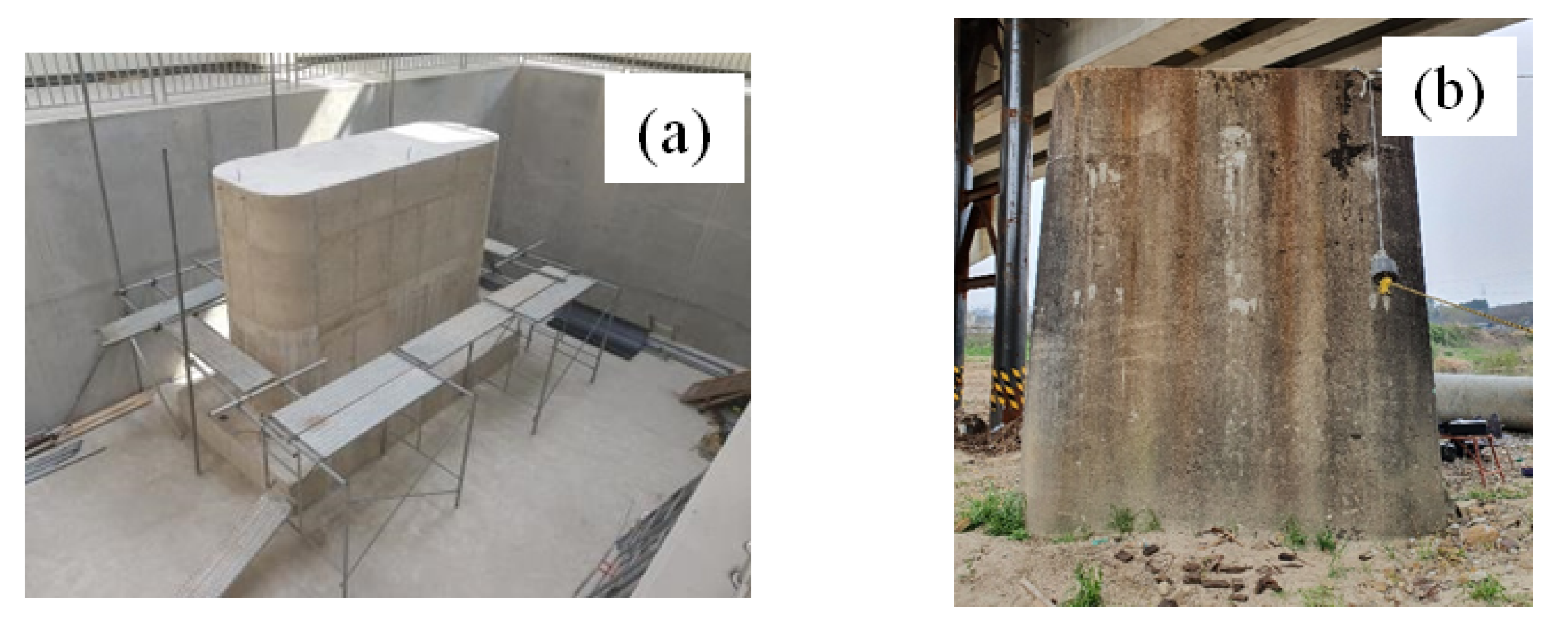
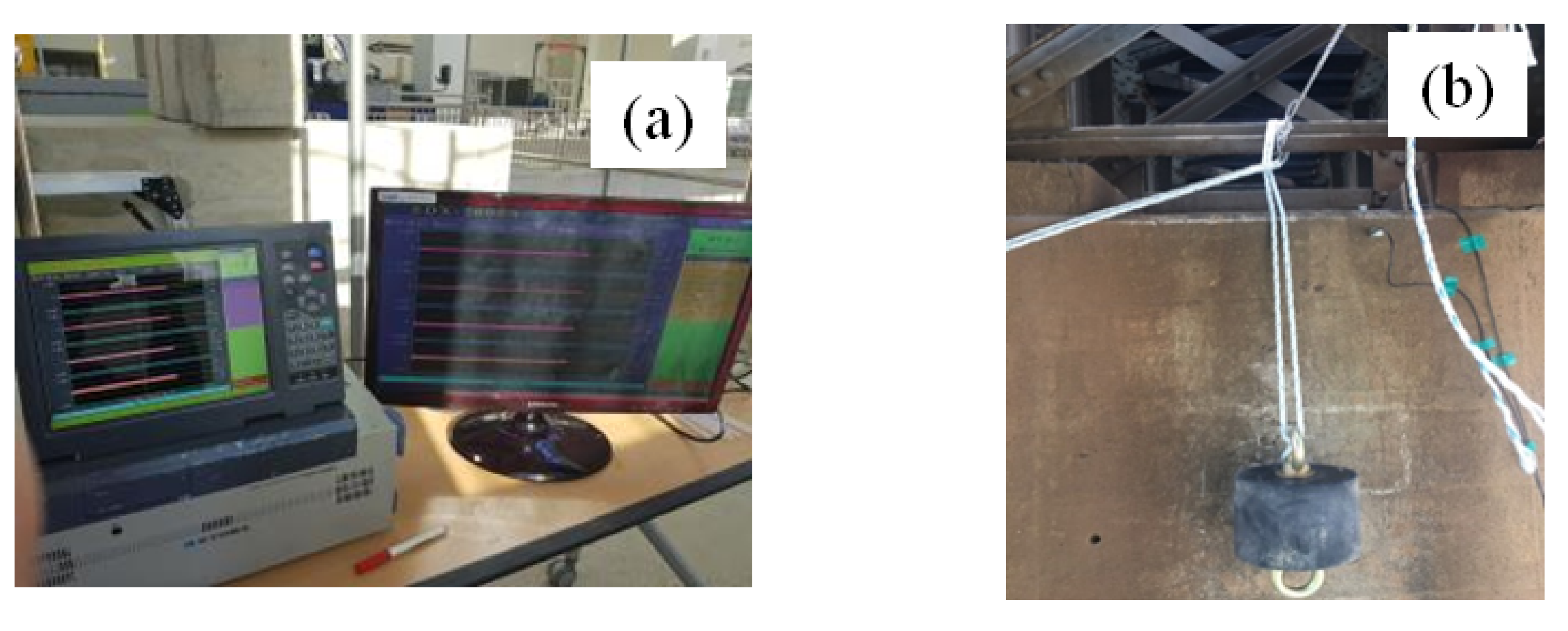
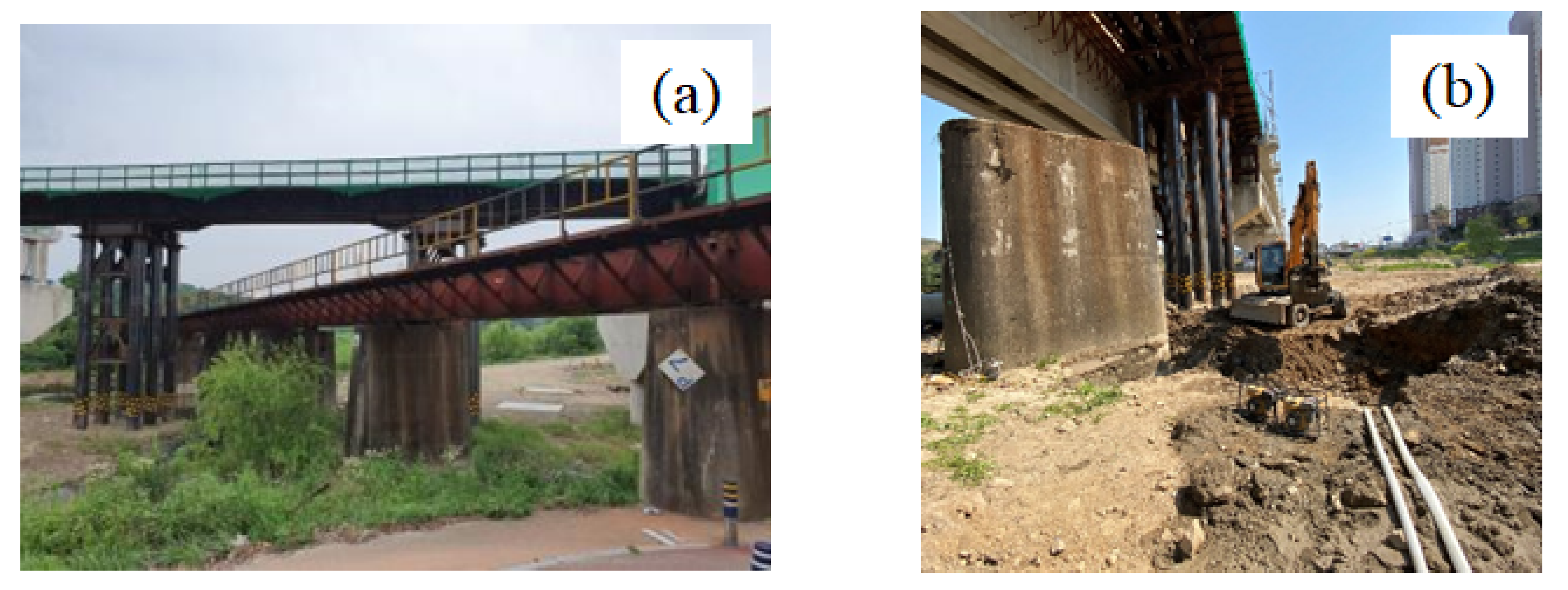
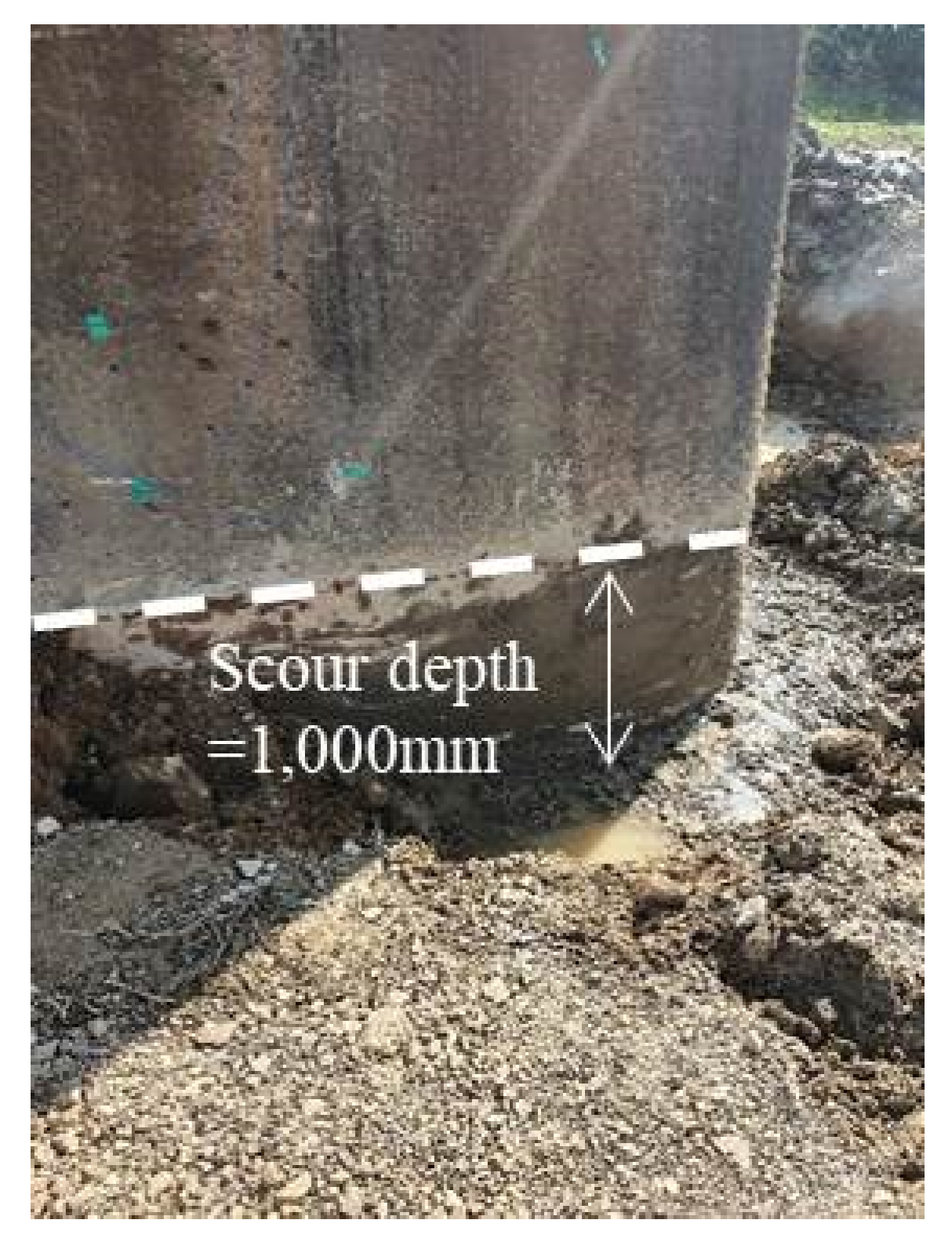
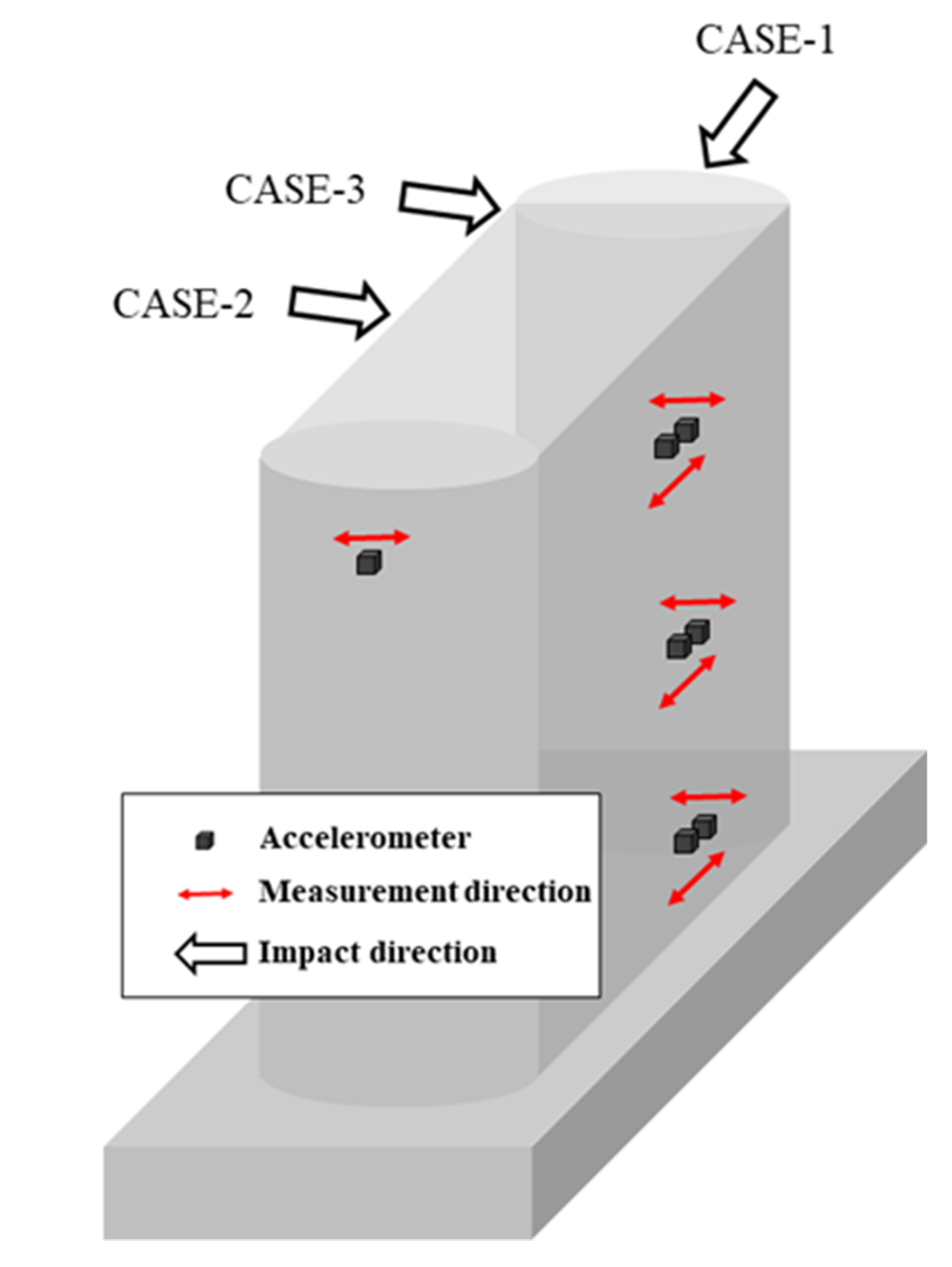

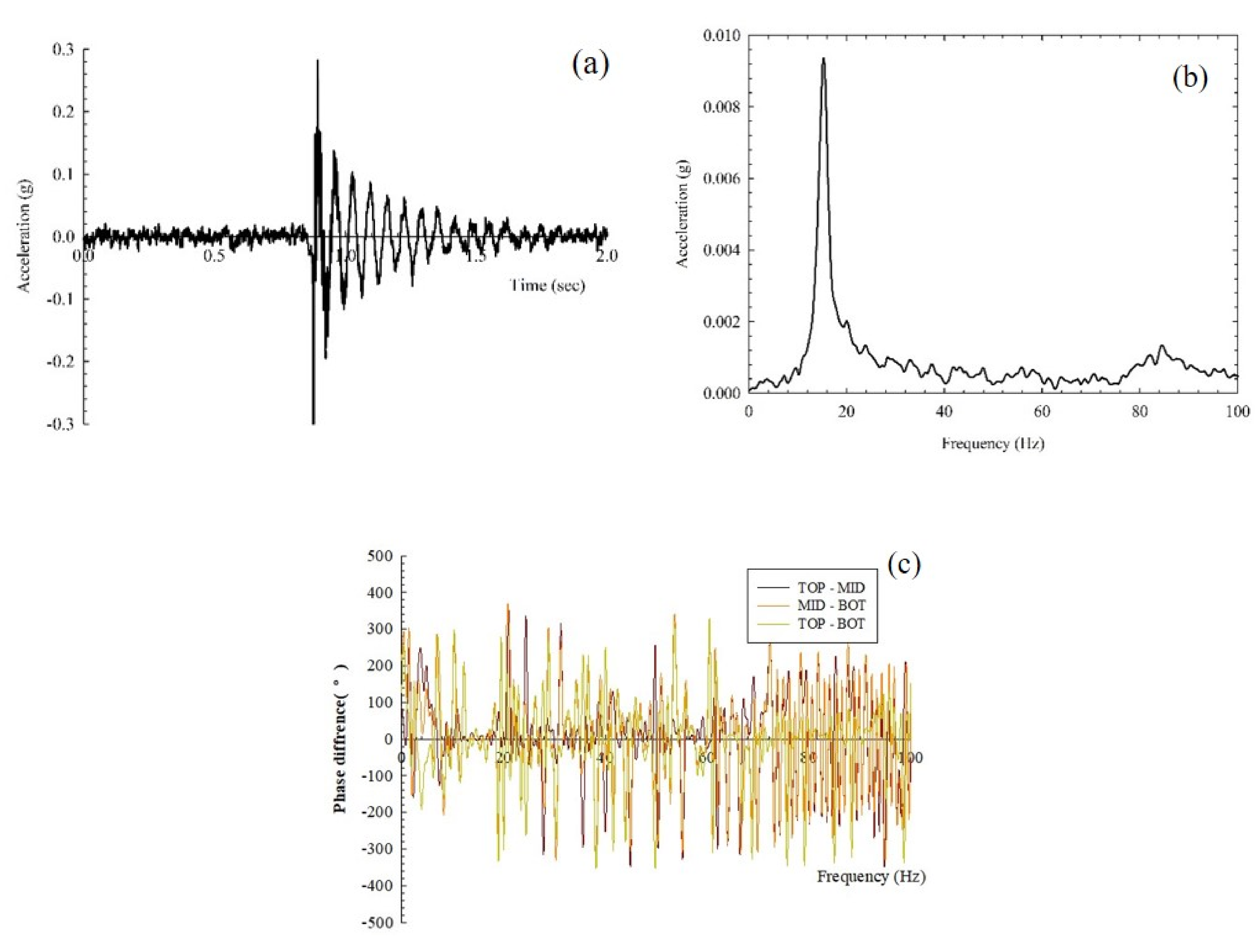
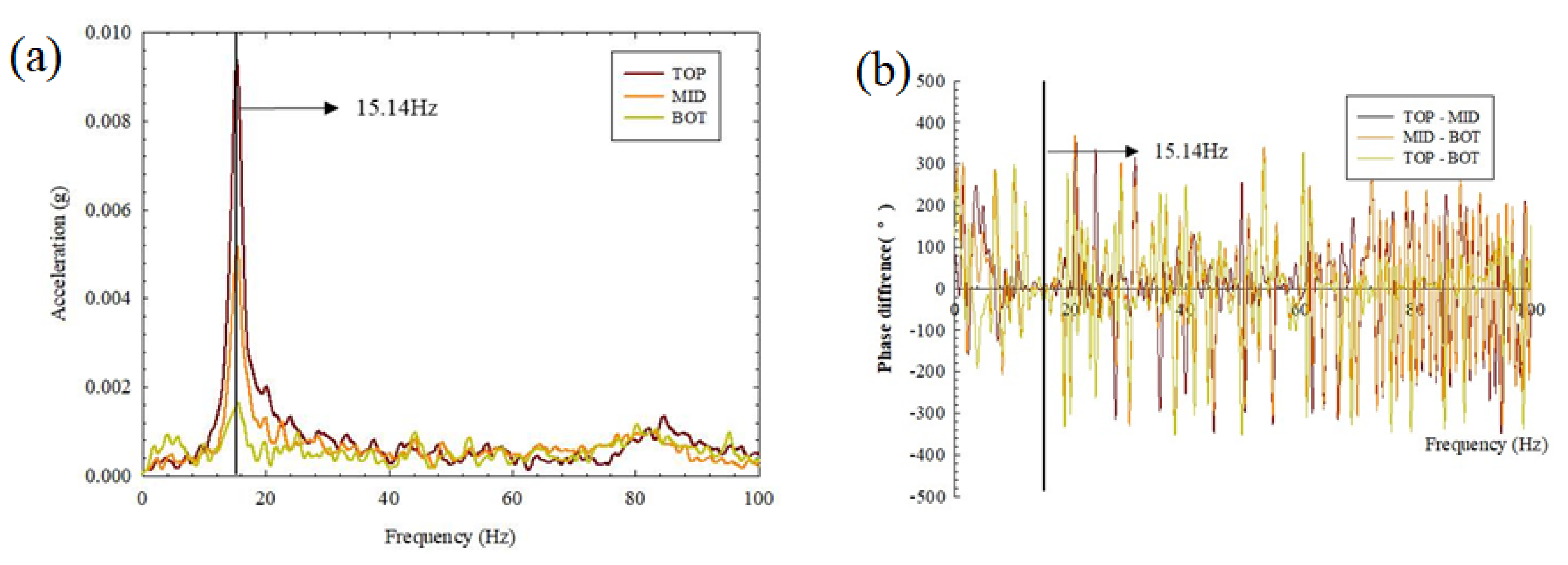


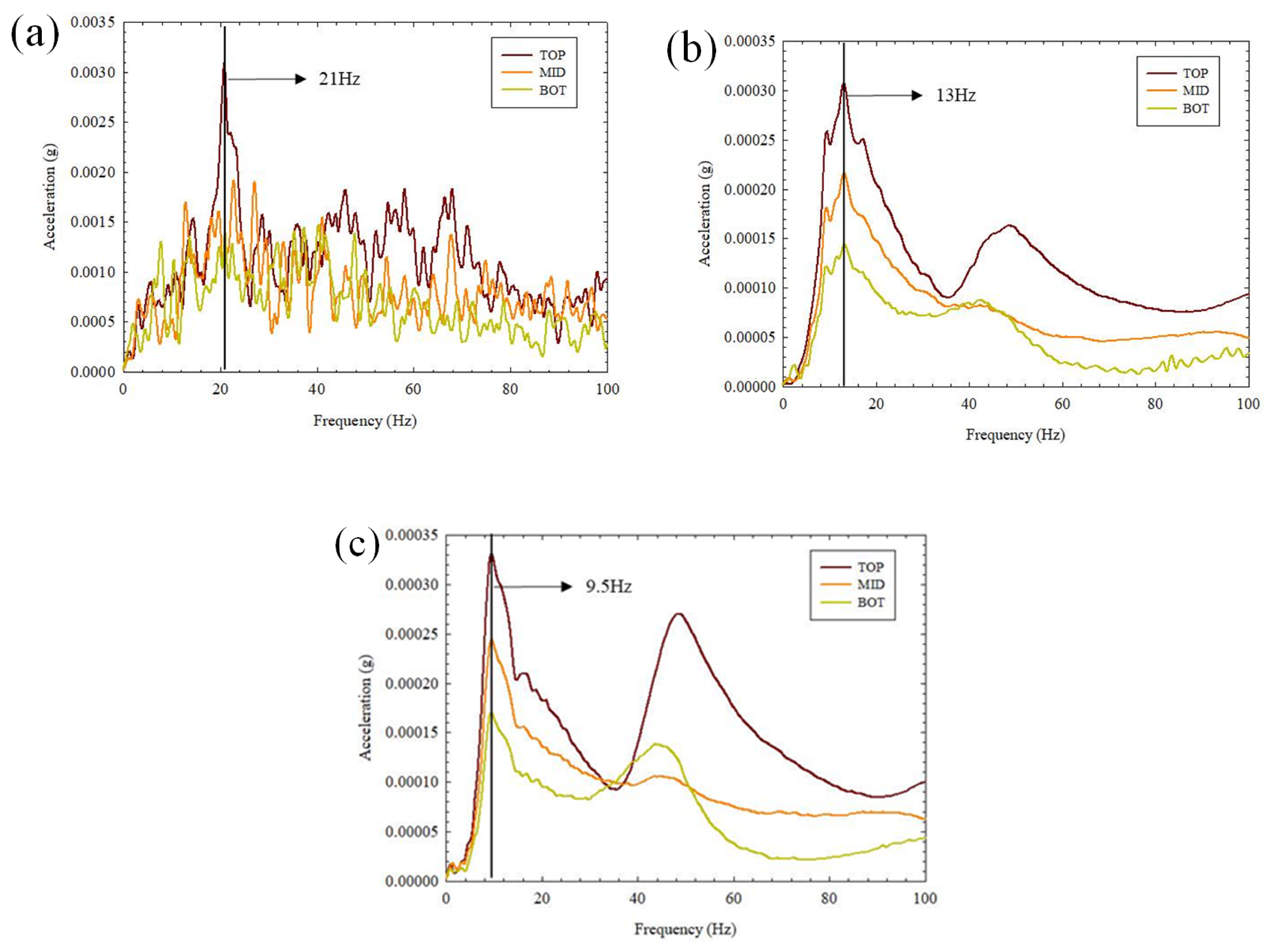
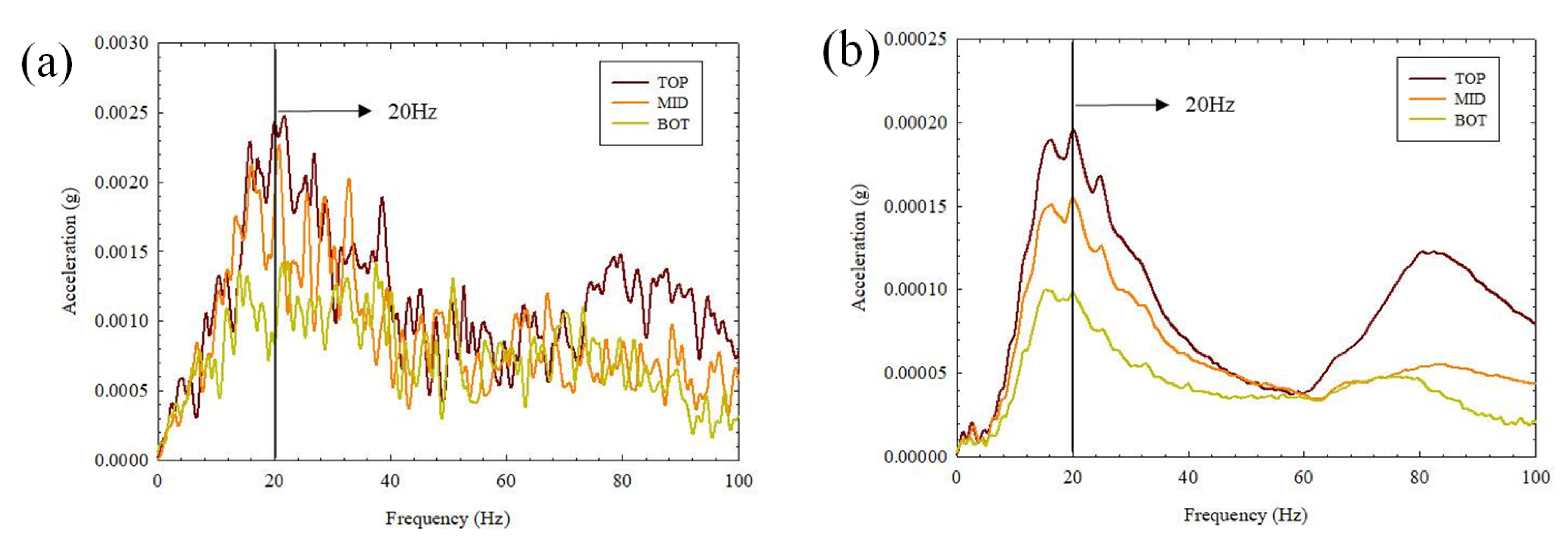
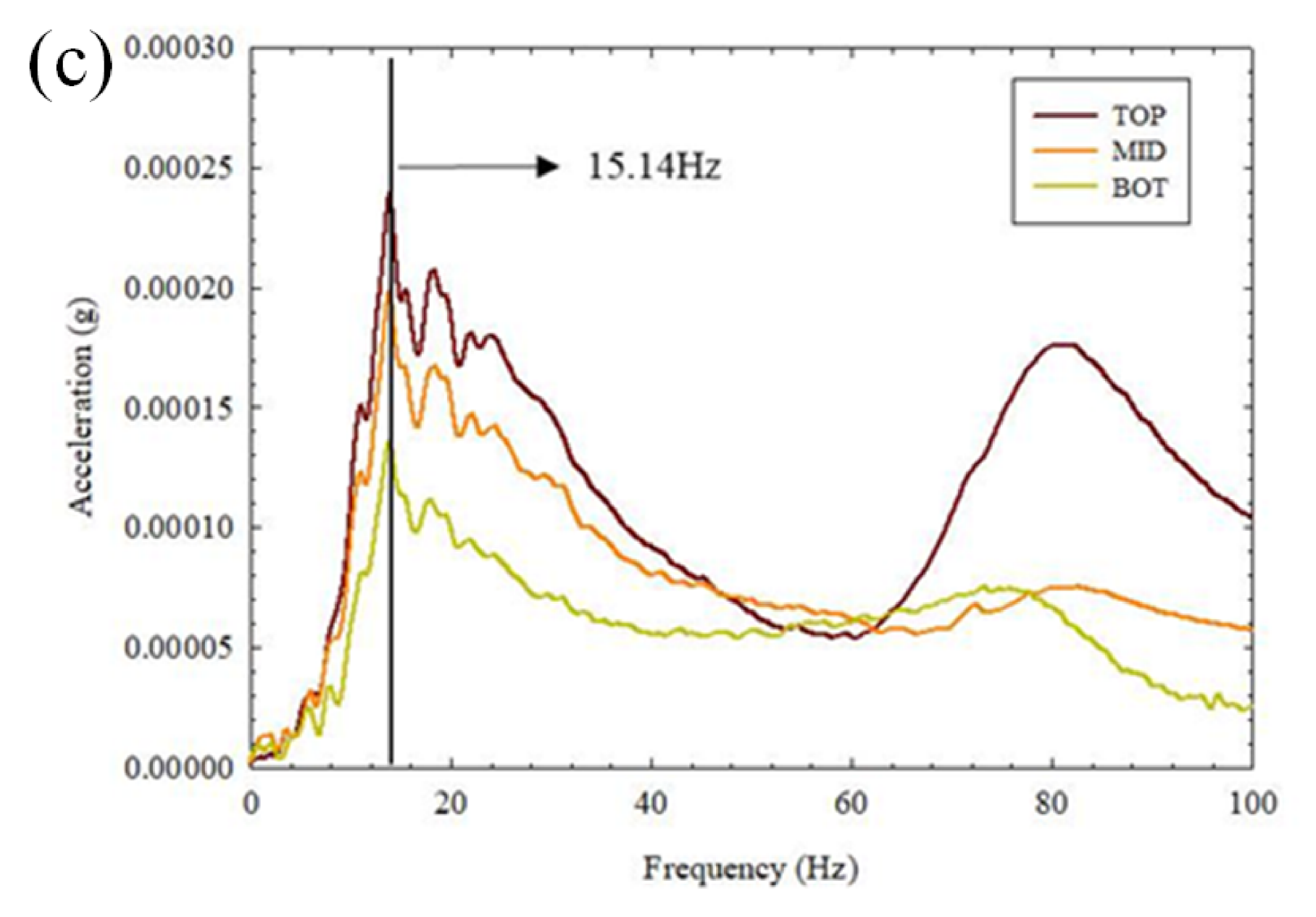
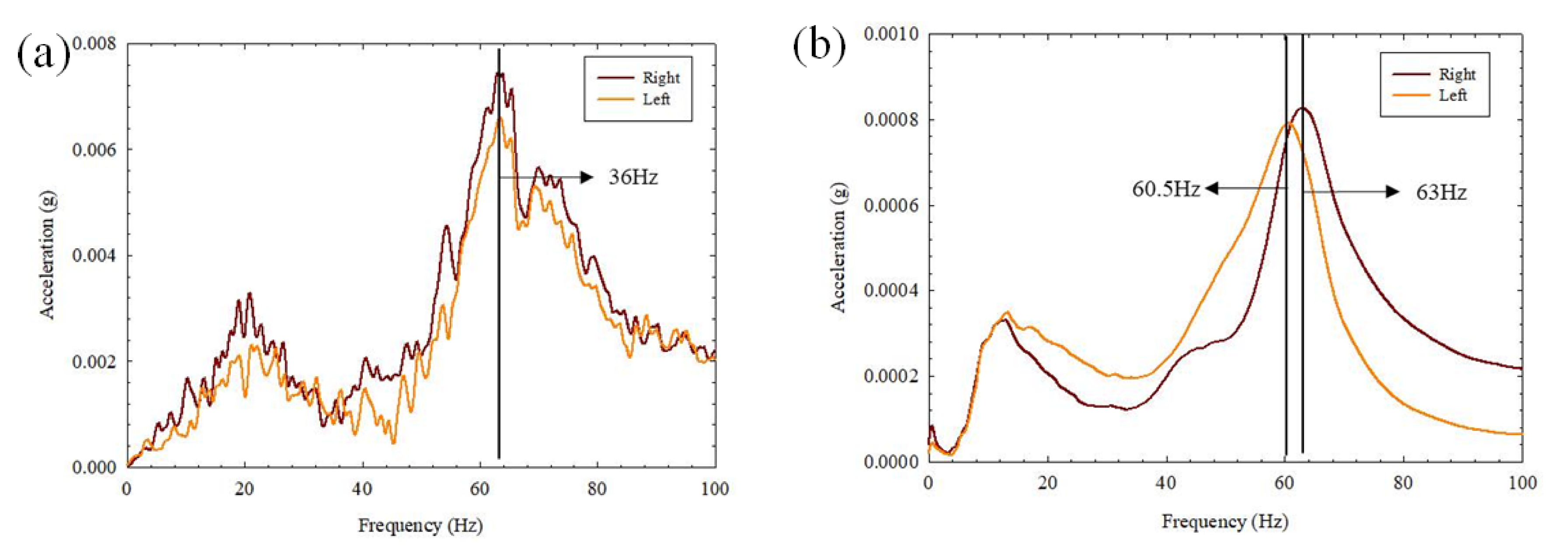
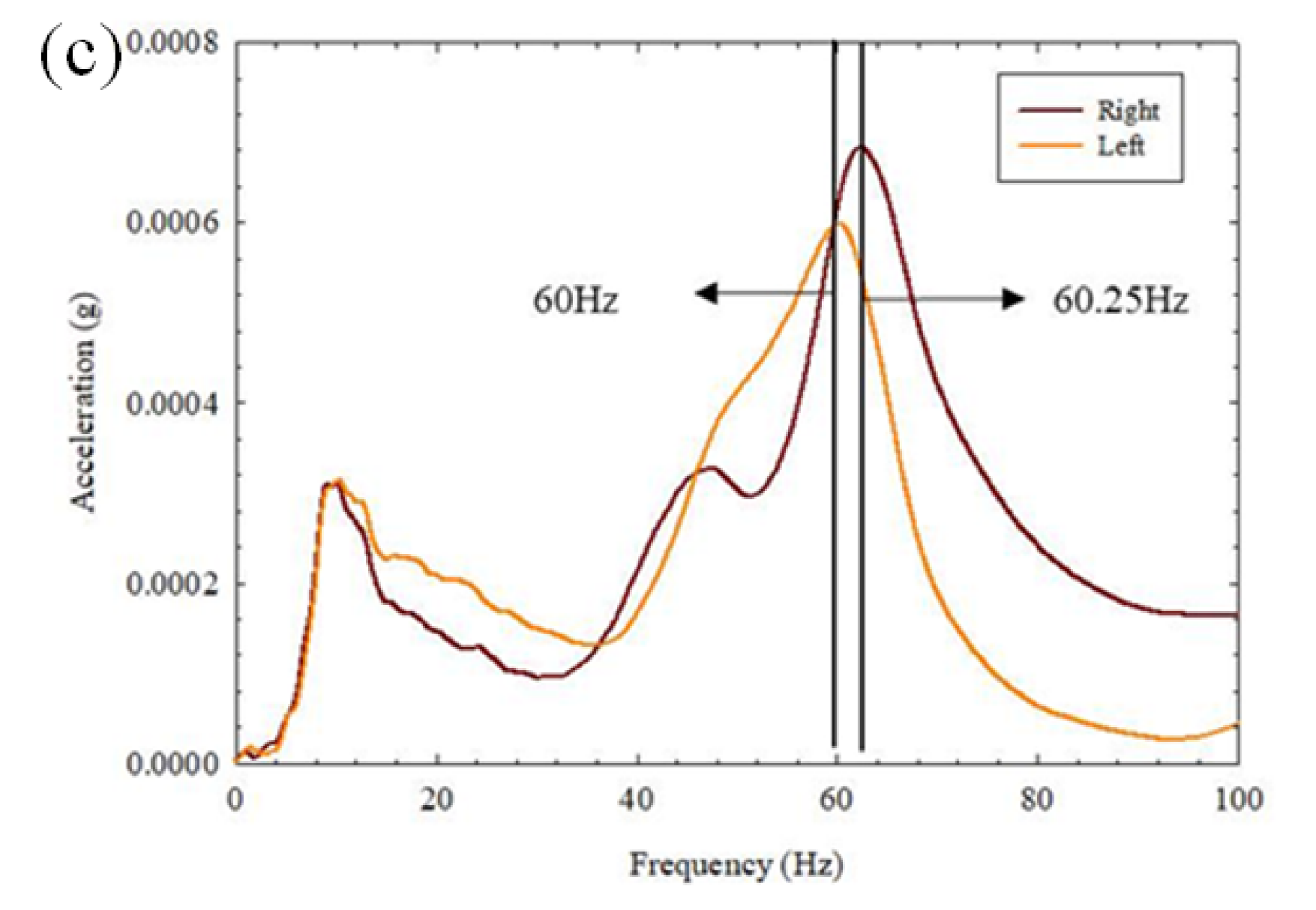
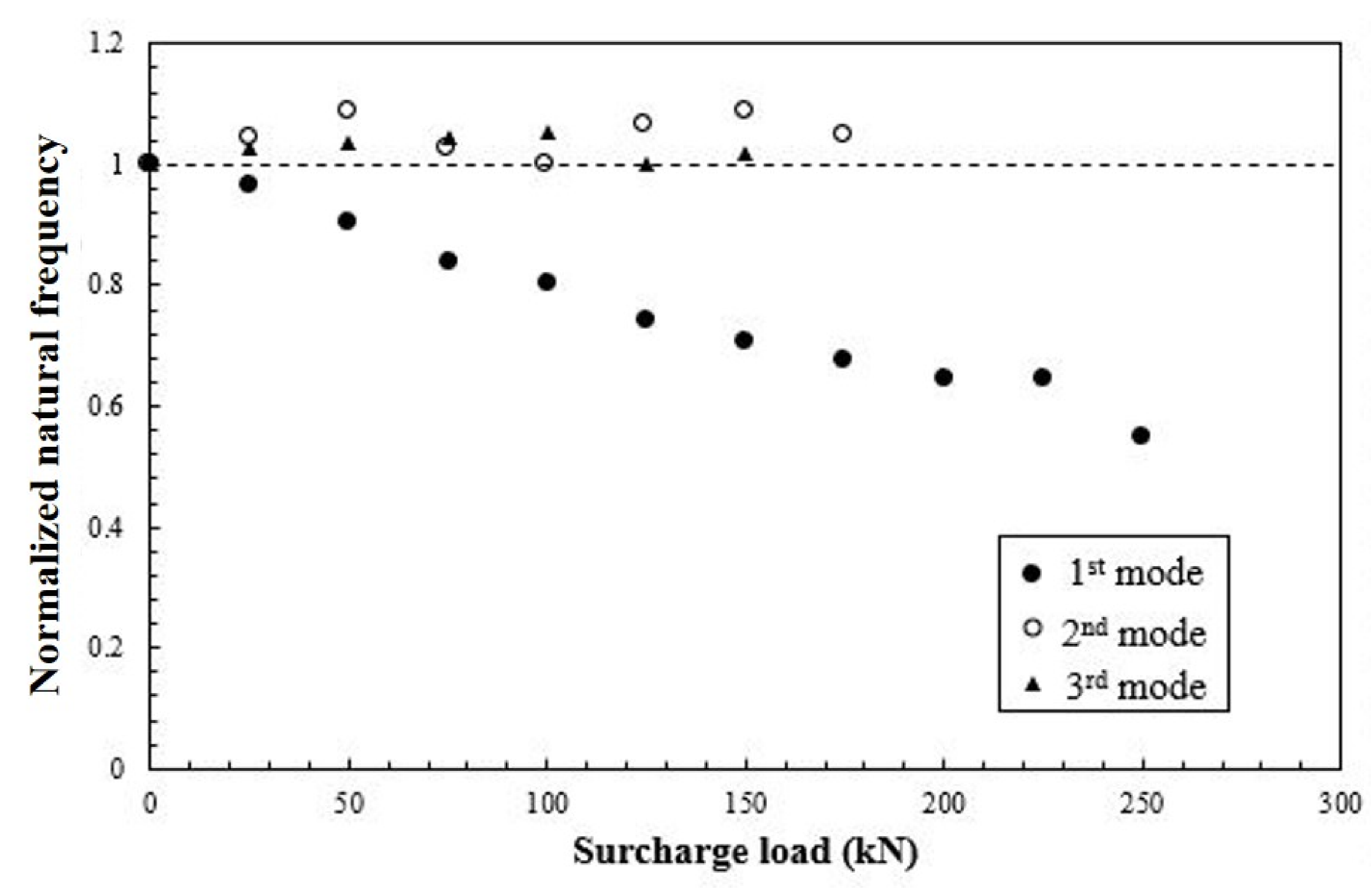
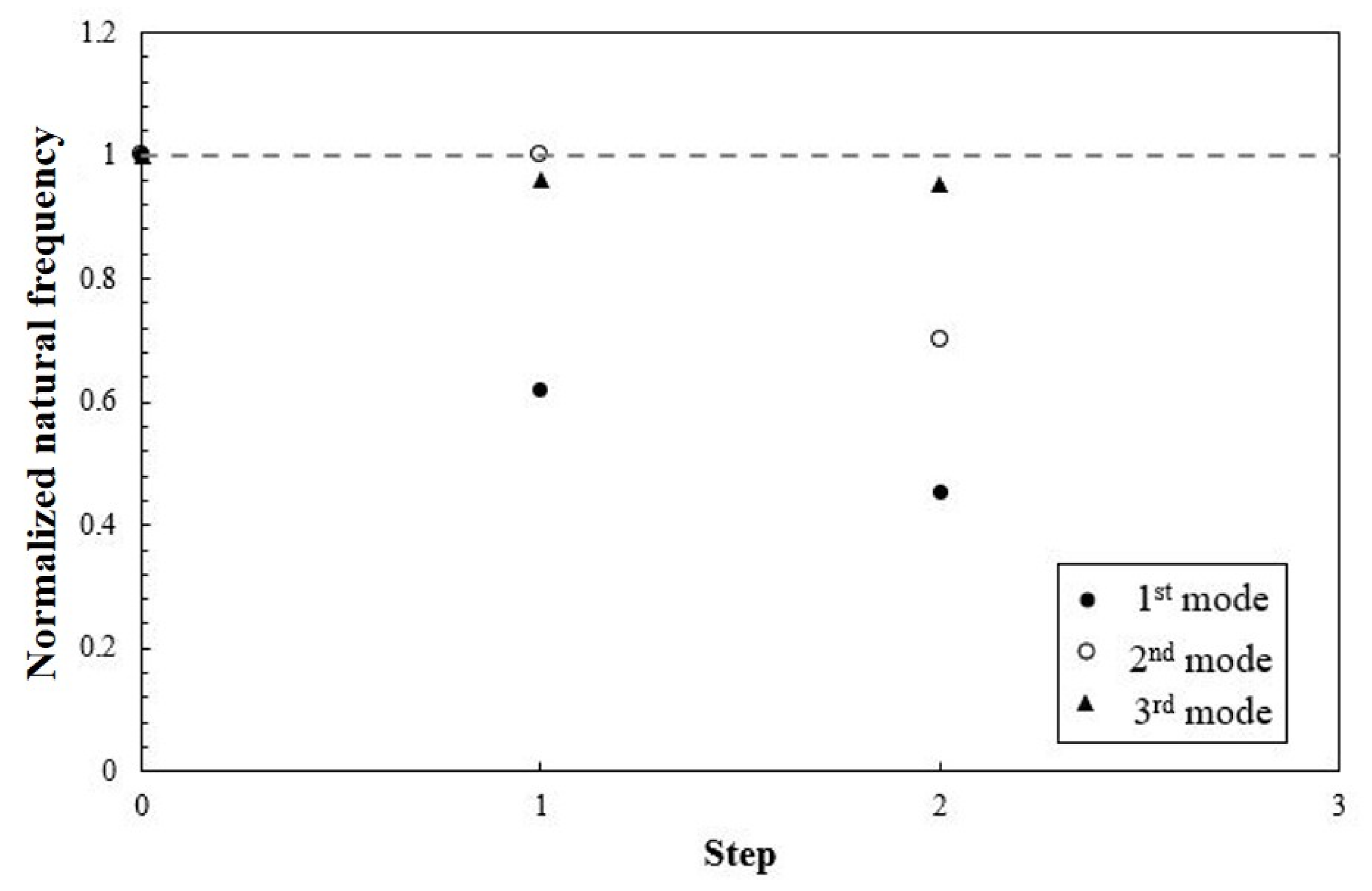
| Classification | Impact Direction | Surcharge Load | Scour | Impact Location | |
|---|---|---|---|---|---|
| Full-scale pier model test | Case-1 | Pier length direction | 0–250 kN (increase by 25 kN) | N/A | Top of the pier |
| Case-2 | Bridge axis direction | ||||
| Case-3 | Bridge axis direction (outside) | ||||
| Field test | Case-1 | Pier length direction | N/A | 1-m depth | |
| Case-2 | Bridge axis direction | ||||
| Case-3 | Bridge axis direction (outside) | ||||
| Surcharge Load (kN) | First Mode (Hz) | Second Mode (Hz) | Third Mode (Hz) |
|---|---|---|---|
| 0 | 22.40 | 15.14 | 54.19 |
| 25 | 23.40 | 14.65 | 55.66 |
| 50 | 24.40 | 13.67 | 56.12 |
| 75 | 22.95 | 12.70 | 56.61 |
| 100 | 22.40 | 12.20 | 57.12 |
| 125 | 23.90 | 11.23 | 54.20 |
| 150 | 24.40 | 10.74 | 55.18 |
| 175 | 23.50 | 10.25 | 55.66 |
| 200 | N/A | 9.766 | N/A |
| 225 | N/A | 9.765 | N/A |
| 250 | N/A | 8.3 | N/A |
| Test Condition | Bridge Axis Direction (Hz) (First Mode) | Pier Length Direction (Hz) (Second Mode) | Torsion (Hz) (Third Mode) | |
|---|---|---|---|---|
| Left (with Scour) | Right (without Scour) | |||
| With a girder | 21 | 20 | 63 | 63 |
| Without a girder | 13 | 20 | 60.5 | 63 |
| Without a girder and simulated 1 m deep scour | 9.5 | 14 | 60 | 62.5 |
© 2020 by the authors. Licensee MDPI, Basel, Switzerland. This article is an open access article distributed under the terms and conditions of the Creative Commons Attribution (CC BY) license (http://creativecommons.org/licenses/by/4.0/).
Share and Cite
Lee, M.; Yoo, M.; Jung, H.-S.; Kim, K.H.; Lee, I.-W. Study on Dynamic Behavior of Bridge Pier by Impact Load Test Considering Scour. Appl. Sci. 2020, 10, 6741. https://doi.org/10.3390/app10196741
Lee M, Yoo M, Jung H-S, Kim KH, Lee I-W. Study on Dynamic Behavior of Bridge Pier by Impact Load Test Considering Scour. Applied Sciences. 2020; 10(19):6741. https://doi.org/10.3390/app10196741
Chicago/Turabian StyleLee, Myungjae, Mintaek Yoo, Hyun-Seok Jung, Ki Hyun Kim, and Il-Wha Lee. 2020. "Study on Dynamic Behavior of Bridge Pier by Impact Load Test Considering Scour" Applied Sciences 10, no. 19: 6741. https://doi.org/10.3390/app10196741
APA StyleLee, M., Yoo, M., Jung, H.-S., Kim, K. H., & Lee, I.-W. (2020). Study on Dynamic Behavior of Bridge Pier by Impact Load Test Considering Scour. Applied Sciences, 10(19), 6741. https://doi.org/10.3390/app10196741





